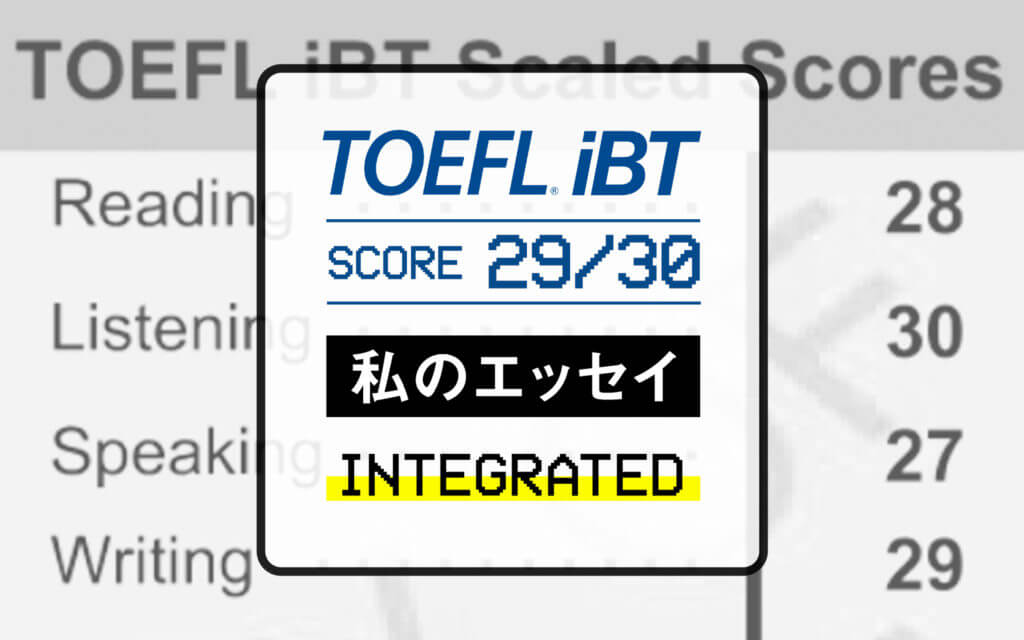こんにちは!ATSUです。
実際に使用したテンプレートを見る前に、簡単にTOEFL iBTライティングの内容をおさらいしようと思います。
TOEFL iBTのライティングでIntegrated writing(総合問題)とIndependent writing (独立問題)の2種類のタイプの問題が出題されます。
Contents
Integrated Writing(総合問題)の概要
まずは今回お話するTOEFL iBTライティング(integrated問題)の全体の流れを理解するところから始めましょう。
Integrated問題には以下の3つのフェーズがあります。
- リーディング(3分)
- リスニング(約2分)
- ライティング(20分)
一応セクションはライティングですが、見てわかる通りリーディングとリスニングの能力も必要で、自分の英語力が総合的に試される問題です。
問題となるライティングの内容はリーディングとリスニングの要約で、語数の目安は 問題文によると150 語~225 語です。採点基準や文字数による得点の変化は以下にまとめていますので見ていない方は見てみましょう。
-
-
英語のライティングでもうアイディアに困らない超マル秘方法【お金・時間・健康】
こんにちは!ATSUです。 今回は、英語のライティングのコツについてお話ししたいと思います。 「ライティングを書く時に何 ...
それでは一つ一つのフェーズをもう少し細かく見ていきましょう。
リーディング(3分)
最初のフェーズは3分間のリーディングです。読むリーディングの内容は選挙、動物、経済など様々で、大学の授業を想定したものになっています。
読むリーディングは必ず4つのパラグラフで構成されている
この時読むリーディングは必ず4つのパラグラフで構成されています。必ず4つです。
そして、それぞれのパラグラフには必ず以下の内容が書いています。
パラグラフ2~賛成/反対する理由1
パラグラフ3~賛成/反対する理由2
パラグラフ4~賛成/反対する理由3
ETSのサンプル問題も使って見てみましょう。
In traditional voting, one major source of inaccuracy is that people accidentally vote for the wrong candidate. Voters usually have to find the name of their candidate on a large sheet of paper containing many names—the ballot—and make a small mark next to that name. People with poor eyesight can easily mark the wrong name. The computerized voting machines have an easy-to-use touch-screen technology: to cast a vote, a voter needs only to touch the candidate’s name on the screen to record a vote for that candidate; voters can even have the computer magnify the name for easier viewing.
Another major problem with old voting systems is that they rely heavily on people to count the votes. Officials must often count up the votes one by one, going through every ballot and recording the vote. Since they have to deal with thousands of ballots, it is almost inevitable that they will make mistakes. If an error is detected, a long and expensive recount has to take place. In contrast, computerized systems remove the possibility of human error, since all the vote counting is done quickly and automatically by the computers.
Finally some people say it is too risky to implement complicated voting technology nationwide. But without giving it a thought, governments and individuals alike trust other complex computer technology every day to be perfectly accurate in banking transactions as well as in the communication of highly sensitive information.
1つ目のパラグラフでは必ず筆者の意見が書いてある
一つ目のパラグラフでは、筆者がトピックに関して賛成か反対かはっきりと意見を述べます。
今回の例でいえば、
現在のアメリカでの投票システムは非効率でしばしば不正確な投票計算をまねく。
という部分です。
残り3つのパラグラフでは絶対に意見をサポートする理由が書いてある
そして、次に3つのパラグラフが続きます。
ETSの例でも
Para 2. Another major problem with…
Para 3. Finally some people say…
と続いていますね。
それぞれのパラグラフでは、筆者が必ず1つ、自分の主張が正しいことを証明するための理由を言います。
また、一つのパラグラフで複数の理由を言ったりすることはありません。必ず1パラグラフにつき1つの意見が書いています。つまりリーディングを全部読むと筆者の
主張+3つの理由について分かるようになっています。
今回の場合
人々が間違った候補者の投票してしまう“they rely heavily on people to count the votes”
人間のカウントに強く依存している“it is too risky to implement complicated voting technology nationwide”
複雑な投票技術を全国で実施するのはリスキーだ
という3つのサポート理由があり、それぞれに具体例が示されていますね。
これはどの問題でも同じです。
ノートテイキング~リーディング
Integrated writingでのリーディングの中身が分かったところで、試験中に何をノートテイキングすべきかも理解しておきましょう。
リーディングの内容は
・サポート理由1
・サポート理由2
・サポート理由3
でしたね。
そしてこの4つの情報は、あとで紹介するライティングテンプレートに直接当てはめていくことになりますので、必ず書き留めておく必要があります。
そして、この一つ一つのボックスに必要情報を書き込みます。これが後でライティングをするときにものすごい重要になってきますので、必ず練習してこの4つの情報を書けるようにしておきましょう。
リスニング(約2分)
次に、教授のレクチャーを聞きます。
このレクチャーの内容は、ほぼ必ず先ほど読んだリーディングの筆者の主張に反対する内容です。なので、例えばリーディングの内容が「勉強は集団でした方が効果的だ」という主張であれば、教授は必ず「勉強は一人でした方が効果的だ」という内容で話を進めます。
リーディングも教授も同じ意見ということはありません。必ずリーディングとリスニングの内容は反対になっています。ETSのサンプル問題もみながら理解していきましょう。
リスニングでは反対理由3つが示される
そして、ここで重要なのは、教授はリーディングの主張3つそれぞれに対して反対の理由を述べます。
つまり、リーディングで賛成の理由が3つであったように、それに反論する際の理由も3つなのです。
今回の場合ですと
“current voting systems used in the United States are inefficient and often lead to the inaccurate counting of votes”
現在のアメリカでの投票システムは非効率でしばしば不正確な投票計算をまねく。理由1
“people accidentally vote for the wrong candidate”.
人々が間違った候補者の投票してしまう
理由2
“they rely heavily on people to count the votes”
人間のカウントに強く依存している
理由3
“it is too risky to implement complicated voting technology nationwide”
複雑な投票技術を全国で実施するのはリスキーだ
というリーディングの内容でしたね。
これに対してリスニングでは
“it’s doubtful that computerized voting will make the situation any better”
理由1
“People who can’t afford computers, people who don’t use them on a regular basis—these people will have trouble using computerized voting machines. These voters can easily cast the wrong vote or be discouraged from voting altogether because of fear of technology.”理由2
“After all, computers are 24 programmed by humans, so “human error” can show up in mistakes in their programs. And the errors caused by these defective programs may be far more serious. The worst a human official can do is miss a few ballots. But an error in a computer program can result in thousands of votes being miscounted or even permanently removed from the record. And in many voting systems, there is no physical record of the votes, so a computer recount in the case of a suspected error is impossible!”
理由3
“As for our trust of computer technology for banking and communications, remember one thing: these systems are used daily and they are used heavily. They didn’t work flawlessly when they were first introduced. They had to be improved on and improved on until they got as reliable as they are today. But voting happens only once every two years nationally in the United States and not much more than twice a year in many local areas. This is hardly sufficient for us to develop confidence that computerized voting can be fully trusted.”
というように、リーディングでの主張理由を教授が一つ一つダメ出しするような内容になります。これがTOEFL iBTライティングにおけるintegrated問題の最初の2フェーズの流れですね。
ノートテイキング~リスニング
リスニングの中身が分かったところで、試験中に何をノートテイキングすべきかも理解しておきましょう。
リスニングの内容も
・サポート理由1
・サポート理由2
・サポート理由3
なので、リスニング中はこの4つをいかに書くかが鍵になります。
ライティング(20分)
ここから、ついに20分間のライティングが始まります。この時の問題は必ずこれです。
ほぼ間違いなくこれです。なので特にどんな問題が出るのか心配する必要はありません。必ず毎回同じことが聞かれます。英語だと
みたいな感じの文章です。質問の文章は毎回若干違いますが、聞いている内容は一緒です。
さてそれでは実際にどのようにライティングを書いていけばいいのでしょうか。
Integrated Writingの基本構成~必ず4パラグラフ
Integrated問題のライティングは常に4パラグラフ構成でいきます。5パラグラフでも、3パラグラフでもダメです。必ず4パラグラフ構成です。なぜでしょうか。
これは、これまで見てきたリーディングとリスニングの構成を見れば一目瞭然です。これまで見てきた最初の2つのフェーズを思い出してみてください。リーディングの内容もリスニングの講義内容も、
- 主張
- 理由1
- 理由2
- 理由3
という4つの構成要素からなっていましたよね?
そして今回の問題はこれらの内容を要約することです。それを考えると、自然とライティングも4つの構成要素で書くことが一番論理的なアプローチだということが分かりますね。
Integrated Writingの内容は何を書けばいい?
今回のライティングは4つのパラグラフで構成されることが分かりました。
それではそれぞれのパラグラフでは何を書けばいいのでしょうか?もう皆さんお気づきかもしれませんね。ライティングは以下のような構成になります。
【パラグラフ1】リーディングではAと言っているが教授それは間違っている言っている。
【パラグラフ2】リーディングではXという理由でAが正しいと言っているが、教授はX1という理由でXは間違っていると言っている。
【パラグラフ3】リーディングではYという理由でAが正しいと言っているが、教授はY1という理由でXは間違っていると言っている。
【パラグラフ4】 リーディングではZという理由でAが正しいと言っているが、教授はZ1という理由でXは間違っていると言っている。
終了です。たったこれだけです。ライティング自体は簡単そうですよね?
内容としてはリーディングとリスニングの主張と3つの理由がそれぞれパラグラフにまとめただけです。また、今回の問題はあくまでリスニングとリーディングの内容をまとめるように言っており、自分の意見を述べるようには言っていません。それゆえ、自分の意見は一切書く必要がありません。
TOEFL iBT Integrated Writingで使えるテンプレートはこれだ!
最後に、私が使用したとっておきのテンプレートをご紹介します。先ほどもお話したように4パラグラフ構成で、リスニングとリーディングの主張と3つの理由が自然にまとめられるようになっています。
TOEFL iBT Integrated Writingテンプレート
The article explains that ______________and provides three supporting reasons. However, the professor says that ____________and refutes each of the author’s points.
First, the reading says that _________________. The professor refutes this point by stating that __________. He claims that _____________.
Second, the article states that ________________. Nonetheless, the professor says that _____________.
According to the professor, __________________.
Third, the reading says that _________________. The professor opposes this point by claiming that ________. He also explains that________________.
イントロではリーディングとリスニングの主張で一文ずつですね。そしてボディではリーディングでのサポート理由、教授のサポート理由、そして教授のサポート理由の具体的説明の3文が1セットになります。
結果自動的に合計11文で構成されるライティングが完成し、文字数も大体280語くらいになるはずです(問題によると目安は150 語~225語です)。
まとめ
以上がTOEFLのライティングパートの概要でした。
これからTOEFLの試験んを受ける場合、まずはここで紹介した形式を完璧に把握してから勉強を把握しましょう。すると、行うべき勉強がはっきりと見えてきて、点数の伸びも効果的に伸ばしていくことができます。
頑張りましょう。
















